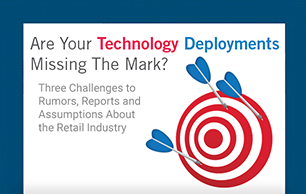 Benjamin Franklin said, “By failing to prepare, you are preparing to fail.” No words could be more true when it comes to large-scale, multi-site technology deployments. Retailers spend inordinate amounts of time, money and resources planning complex technology deployments that deliver their companies into the digital age. They research, test and vet technologies, rally teams to support implementation, and secure budget approvals. Once all of this is complete, they are ready for deployment, but are they really prepared?
Benjamin Franklin said, “By failing to prepare, you are preparing to fail.” No words could be more true when it comes to large-scale, multi-site technology deployments. Retailers spend inordinate amounts of time, money and resources planning complex technology deployments that deliver their companies into the digital age. They research, test and vet technologies, rally teams to support implementation, and secure budget approvals. Once all of this is complete, they are ready for deployment, but are they really prepared?
In too many cases, the answer is a resounding “no!” Why not? Well, in the midst of all of the planning, companies often account for every aspect except site readiness: Is the physical layer infrastructure capable of supporting the new technology and supporting it well? Without site readiness assessments, retailers often experience unexpected delays, additional equipment expenses, and/or inadequate performance of the new technology once it’s deployed.
The following high-level site readiness checklist is indicative of some of the aspects of evaluating the physical layer that should precede technology rollouts.
- Is there sufficient electrical power to run the new equipment?
- Do you have sufficient routing and switching to support the new applications?
- Is there space available in the rack? How many positions are available?
- Have you assigned the designated ports?
- Are servers updated with required OS/platform to run the new technology?
- If it is a wireless application, can your wireless infrastructure support the additional traffic?
- Is a wireless upgrade required and, if so, are new switches and/or access points required?
- Do you have the proper router/firewall/ security appliance in place?
- Does the security application have the proper OS level?
- Do you need additional PDUs in the rack?
A site readiness assessment is a simple, relatively inexpensive process that returns massive benefits to the retailer.
- Minimize execution risk, costly change orders, and site revisits by having complete information prior to project kick-off.
- Ensure successful, on time deployments.
- Ensure new technologies go live with maximum performance and capabilities with proper network support.
- Speed time to deployment and ROI by minimizing problems and delays.
With more than 35 years of large-scale, multiple-site deployments under our belt, Telaid is a major proponent of site readiness assessments. For more information about how we conduct them and how they can help ensure the success of your next deployment, contact us.
Caught in the fray between IP and analog video? HD-analog may be the solution for you.
Here are some of the pros and cons.
 The migration from standard definition analog to IP network cameras has been going on now for over a decade. Depending on the information source, IP video systems’ revenue surpassed legacy analog in late 2013 or early 2014, and has widened the gap further since then. Yet there are still vast quantities of analog systems deployed, keeping the technology relevant for the foreseeable future. Now there is the emergence of a new trend in the industry has at least slowed IP’s march to market dominance. Since its introduction in 2013, HD-analog has experienced incredible year-over-year growth. Though IP continues to lead the industry, HD-analog may be a more suitable third option for particular end users who have an end-of-life video security system, but are not yet ready to make the leap to network video.
The migration from standard definition analog to IP network cameras has been going on now for over a decade. Depending on the information source, IP video systems’ revenue surpassed legacy analog in late 2013 or early 2014, and has widened the gap further since then. Yet there are still vast quantities of analog systems deployed, keeping the technology relevant for the foreseeable future. Now there is the emergence of a new trend in the industry has at least slowed IP’s march to market dominance. Since its introduction in 2013, HD-analog has experienced incredible year-over-year growth. Though IP continues to lead the industry, HD-analog may be a more suitable third option for particular end users who have an end-of-life video security system, but are not yet ready to make the leap to network video.
What is HD-analog?
In simplest terms, HD-analog is a system of cameras and recorder(s) that allows the end user to view live and recorded analog video, using coaxial cable or Category cable with baluns, in High Definition (HD). There are three prevailing formats of HD-analog technology: CVI, TVI, and AHD, starting with the launch of CVI by Dahua in 2013. However, HD-analog platforms were all preceded by HD-SDI going back to 1989. HD-SDI, though not the same as HD-analog in format, is at least similar in concept to AHD, CVI, and TVI. Therefore, SDI format is included in most HD-analog discussions along with the other three technologies.
Why consider HD-analog?
While HD-analog technology is not the ideal solution for all end-users, it is a great option for some. HD-analog may be a good solution for customers who:
- Want to extend the life of already-deployed legacy analog systems, because deployment of new cabling infrastructure makes conversion to a network video solution cost-prohibitive.
- Have limited budget and are seeking a low-cost video system solution.
- Have a smaller camera system deployed (typically 32 cameras or fewer).
- Are primarily interested in viewing live and recorded video; video analytics and business intelligence are not a primary driver of the desired solution.
- Desire a system with limited exposure to the larger network due to resource availability, network support ability, limited network acumen, or network security concerns.
Pros and Cons of HD-analog
Before deciding if HD-analog may be a fit, a closer look into the challenges and benefits is helpful.
PROS
- Labor-Savings – In most situations, existing infrastructure remains in place. The system ends (cameras and recorders) are replaced, but the existing power and cabling are reused.
- Resolution – When first introduced, resolution above 720P was rare. Now all platforms include 1080P as a core offering, and higher resolutions of 3MP, 4MP, and 5MP are available or will be in the immediate future.
- Cost – At the core, the solution is still an analog system with fairly inexpensive components. Prices vary, but a good predictive starting point at the low end is about $150 per camera and $150-$200 per channel for recorder.
- Scalable Retrofit Flexibility – If existing cameras are still usable, HD-analog recorders can also receive signals in standard definition (SD). An existing system can be leveraged and enhanced with the addition of HD-analog cameras to the current system.
CONS
- Integrator Support – HD-analog has still rendered somewhat limited support from security integrators. An integrator poll conducted by IPVM revealed that only 35% of respondents indicated that they provide support for HD-analog.
- Competing “Silo” Technologies – Currently, there is limited-to-no compatibility between HD-analog formats and sometimes even different manufacturers within a format.
- Stop-Gap Perception – Some in the industry look at HD-analog as having a limited “shelf-life,” a stop-gap that allows legacy analog users to hang on to their dying technology a little longer, but which is unlikely to provide a long-term solution for decades to come.
The benefits of HD-analog are fairly straightforward and require little elaboration. In short, HD-analog extends the capabilities of the existing analog system, buying it higher resolution for better imaging without investing in an entirely new IP system and required infrastructure.
Lack of support is a concern if a preferred integrator partner has chosen not to embrace HD-analog in general, or not support specific HD-analog vendors that an end user may be interested in. This may stem from a prevalent industry mindset that an integrator “cannot be all things to all people.” In other cases, preferred integrator/manufacturer partner relationships may come into play, or there may not appear to be enough profitability due to the lower price points on hardware and the limited amount of labor revenue associated with upgrading a site. At Telaid, we work to maintain an agnostic position on technology solutions of the customer. We have spoken to no fewer than a dozen HD-analog providers over the course of the past year, and we are currently doing business with some of those providers.
Although the HD-analog technologies are “silo” and may create trepidation akin to VHS/Beta or Blu-ray/HD-DVD scenarios of the past, with outstanding year-over-year growth, it does not seem likely that any of these technologies are going away anytime soon. The target market for HD-analog solutions would likely be (or should be) indifferent to incompatibilities between the various competing platforms. However, there are other considerations to take into account before deciding on a specific HD-analog technology. Before finalizing a decision on technology selection, perform due-diligence and fully understand your options.
Whether you plan to invest in network technology or are interested in exploring the option of HD-analog, Telaid can provide insight and deployment support. We pride ourselves on being technology agnostic, looking only to integrate the solution that best meets the needs of each individual customer.




